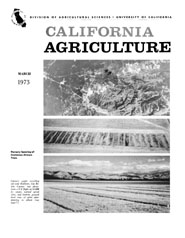|
|||
|
|||

Cover:
Cannery waste recycling site near Hollister, Sun Benito County: top photo from a U-2 flight at 65,000 ft.; center, normal aerial view; and bottom, ground level view of plots after planting to wheat.
March 1973
Volume 27, Number 3 News and opinion |
|||
|
University of California, 1301 S. 46th St., Bldg. 478 Richmond, CA
|